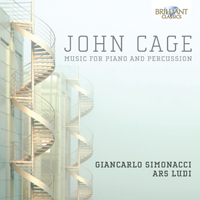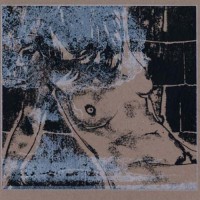Percussion with Pianos
|
Grant Chu Covell [February 2015.]
“One.” Iannis XENAKIS: Rebonds (1987-89). Matthew SHLOMOVITZ: Hi-Hat and Me (2010). Erik GRISWOLD: Chooks! from Old MacDonald’s Yellow Submarine (2009). Laurence CRANE: Solo for Claire Edwardes (2005). Javier ALVAREZ: Temazcal (1984). Stuart GREENBAUM: Clockwork Lemon (2007). Karlheinz STOCKHAUSEN: Aquarius and Taurus from Tierkreis (1975). Frederic RZEWSKI: To the Earth (1985). Roberto SIERRA: Bongo-0 (1982; rev. 2003). Claire Edwardes (perc). Tall Poppies TP 223 (1 CD) (http://www.tallpoppies.net/). There are old and new friends to be found in Edwardes’ excellent recital. One’s theme consists of works requiring a modest setup, several of which were written for Edwardes. Alvarez requires only maracas, Greenbaum a snare drum and hi-hat, Schlomovitz only hi-hat, Rzewski four clay pots, and mere bongos for Sierra. In several pieces the percussionist makes use of her voice: Shlomovitz, Rzewski and Sierra’s pieces include spoken parts. Crane and Alvarez’s works add tape (which admittedly requires a bit more effort in performance). Xenakis’ Rebonds’ two bold sections are taken in the (better) order B, A. Hi-Hat and Me includes vocal imitation of cymbal sounds. The spoken text offers story bits, lists and numbers. It amuses and confounds, and then it’s done. Research reveals that chook is Australian slang for chicken. The note for Chooks! does indicate that its toy piano and woodblock rhythms imitate that barnyard animal. The program’s soberest item, Crane’s Solo, instructs its dedicatee to play against a tape of herself, a gritty accompaniment including what must be slowed percussion gestures. Alvarez’s Temazcal asks the percussionist to execute demanding maracas rhythms in synchrony with tape. Clockwork Lemon for snare and hi-hat, suggesting a Kubrick film, is about how precisely executed rhythms can sound wrong. For the excerpts from Stockhausen’s zodiac, Edwardes employs a toy piano and melodian (a child’s toy with a keyboard and a mouthpiece) in Aquarius, and a toy piano, crotale, and one of Stockhausen’s original music boxes in Taurus. For American ears, Edwardes’ Australian English imparts a welcome slant on the spoken parts of the Rzewski and Sierra.
John CAGE: Sixteen Dances for Soloist and Company of Three (1950-51)1; Credo in US (1942)2; First Construction (in Metal) (1939)3; Trio (1936)4; Double Music (1941, with Lou HARRISON)5; Third Construction (1941)6; Fads and Fancies in the Academy (1940)7. Irene Angelino1 (fl), Marco Toro1 (tpt), David Simonacci1 (vln), Marco Simonacci1 (vlc), Giancarlo Simonacci1,2,7 (pno), Ars Ludi Percussion Ensemble: Rodolfo Rossi1,3,4,5,6,7, Marzio Audino1, Cecilia Martellucci1,3, Andrea Montori1, Antonio Caggiano2,3,4,5,6, Gianluca Ruggeri2,4,5,6,7, Federico Scalas2, Andrea Di Giulio3,7, Fabiana Giangregorio3, Pietro Pompei3, Aurelio Scudetti3, Flavio Tanzi5,6, Francesco Carlo Leone7 (perc); Gianluca Ruggeri1 (cond.). Brilliant Classics 94745 (2 CDs) (http://www.brilliantclassics.com/). Mode’s all-piano variant made me more appreciative of Sixteen Dances, energetic here, but overlong (51:25) and poorly instrumented. If it weren’t Cage, it would have been long forgotten. The other compositions in this collection were created during the preceding two decades. Cage, having “figured out” rhythm in that time, gently misstates Schoenberg’s dictum; he still needed to figure out pitch and harmony. Perhaps the path through chance freed him from worrying about conventional concepts of lines and melodies. Works well after 1950, which may not have had lines that were traditionally composed, are more appealing. Tchaikovsky samples announce this realization of Credo in US for piano, two percussionists, radio and phonograph. We’re treated to a dozen minutes of structured but gentle chaos punctuated with Cuban and jazz rhythms, interrupted by radio and records. This was Cage’s first piece for radio and others’ music. In Credo and the two Constructions, Cage demonstrates sustaining complex rhythms and structures. The Third Construction is especially perky. While the actual organization of expanding and contracting rhythmic units may not be evident, the continual reply of material from varying angles is very clear. Ars Ludi employs a wide variety of instruments, including distinctive gongs and rattles. Fads and Fancies in the Academy is a new one to me. Cage apparently withdrew this satirical work after its poorly received premiere. He dug out the piece and presented it to his publisher in 1992, the year of his death. To be polite, the work’s clapping, whistling, counting, and dance-hall piano gestures are juvenile. Movement titles, “The pupil is eager to learn,” “The pupil is constitutionally lazy,” “We deal with the total child,” could be viewed as harbingers of Cage’s later interest in Zen or Emerson, or perhaps as unvarnished cynicism. Passing moments make this piece worth hearing once or twice, but similar to Sixteen Dances, if this weren’t Cage, no one would give this a second glance. The variations on the opening piano tune did suggest Milhaud, which isn’t much of a stretch given that both composers overlapped at Mills College in the early 1940s.
Paul LANSKY: Textures (2012-13)1; Threads (2005)2. Hammer/Klavier1: Thomas Rozenkranz, Michael Sheppard (pno), Svet Stoyanov, Gwendolyn Burgett (perc); Time Travellers2: Gwendolyn Burgett, Svet Stoyanov, Ian Rosenbaum, Ayano Kataoka (perc). Bridge Records 9435 (1 CD) (http://www.bridgerecords.com/). Setting a lofty bar, Textures credits Bartók as forerunner for the two-piano two-percussionist quartet. Lansky’s entry to the genre is dissimilar, creating generally homophonic, glittering textures and happy neon kaleidoscopes. If Bartók offers a rustic meal set outdoors on uneven ground, Lansky presents tidy place settings under bright light. The percussion-quartet Threads alternates Recitatives, Choruses and Arias, a percussion cantata à la J.S. Bach. It has already found its way in the world via the dedicatee’s recording, Sō Percussion on Cantaloupe (CA21064) which struck me as ho-hum in that guise. Perhaps this release’s timbres are more vivid. Bach’s cantatas transition from one state to another nearly always ending with a sense of arrival. Lansky’s Threads doesn’t describe a transformation; as with Textures, we have a string of set pieces.
“After JSB-RS.” Chris Paul HARMAN: After Schumann I (2008)1; 371 (2006)2; Concertino (2008)3; Der Tag mit seinem Licht (2010-11)4; After Schumann II (2012-13)5. MeiYi Foo1,5 (pno), Toca Loca2: Gregory Oh, Simon Docking (keyboards), Aiyun Huang2 (perc); Yoori Choi3, Jin Hyung Lim3 (keyboards), McGill Percussion Ensemble3, Jeffrey Stonehouse4 (fl), Mark Bradley4 (clar), Mark Fewer4 (vln), Andrea Stewart4 (vlc), Christian Smith4 (perc), Jeremy Chaulk4 (pno), Aiyun Huang3,4 (cond.). Naxos 8.573303 (1 CD) (http://www.naxos.com/). Schumann and Bach stand dimly in the background of these appealing piano and piano-plus-percussion pieces. Generally episodic, the solo-piano cycles are wide-ranging variation sets: After Schumann I presents eight miniatures derived from a piece in Album für die Jugend, Op. 68, and After Schumann II offers 15 miniatures developed from material in Kinderszenen, Op. 15, and Albumblätter, Op. 124. I had expected the sources to be more pronounced, but Harman quickly pushes past the originals into new terrain. After Schumann II is larger, 15:07 compared to I’s 10:28. When etude-like cascades or curious triadic sequences appear, Schumann’s fingerprints extend across the centuries. One of music’s most important numbers (at least to theorists and those with a traditional education), 371 refers to the collection of Bach’s chorales. However, because of the keyboard and percussion, and Bach’s predominantly stepwise motion, Harman’s derivation sounds rather like Bartók. Harman’s doings suggest that the Hungarian composer may have taken his inspiration from Bach. 371’s armamentarium includes prepared piano and other differently tuned instruments, which delightfully enhances pitches and overtones. Harman admits that Bach sparked the Concertino for two keyboard soloists with an eight-person percussion ensemble. Here too, Bach’s material (from the Two-Part Inventions) vanishes under Harman’s skillful development and the entertaining combinations of piano, prepared piano, detuned piano, toy piano, celesta, and all nature of pitched and non-pitched percussion. If Harman had kept his sources to himself, I may never have suspected them. Der Tag mit seinem Licht mutates a particular Bach chorale tune. The Lutheran source varies between wistful and aggressive in this chamber work for flute, clarinet, violin, cello, piano and percussion. Tonality’s gentle coddling recalls Silvestrov’s vein of nostalgia, although Harman does much more with color and texture.
“Five American Percussion Pieces.” Lou HARRISON: Song of Quetzalcoatl (1941)1; Solo to Anthony Cirone (1972)2. Michael BYRON: Trackings I (1976)3. Alvin CURRAN: excerpt from Bang Zoom (1995)4. James TENNEY: Having Never Written a Note for Percussion (1971)5. William Winant Percussion Group1: William Winant, Todd Manley, David Rosenthal, Daniel Kennedy; William Winant2,3,4,5 (perc). Poon Village Records PV 007LP (1 LP) (http://www.forcedexposure.com/). Percussionist Winant has been a big part of American contemporary music, and so it’s hard to reckon that this is his first headline release. Here are recordings going as far back as 1976 (Byron); the newest is from 2013 (Tenney). Harrison’s Song of Quetzalcoatl is a razor-sharp ensemble piece. Notwithstanding the ensemble partiality to Gamelan (gongs, cowbells, etc.), this 6:40 work heads south-of-the-border. Completed in 1941, it’s among the earliest American percussion ensemble pieces, yet it seems so sure and confident. Solo is a short and sweet melodic song (2:46). Byron’s Trackings explores the tinkling unity of light chimes. Curran asks for 13 tuned cowbells. This excerpt (the entirety may run to 35 minutes) contains repeating patterns as found in Baroque busywork. Tenney’s Having Never Written a Note for Percussion was originally written on a postcard. Minimal in nature, there is actually just one “note,” a controlled crescendo / decrescendo, performed here on a gong and extending for nine-and-a-quarter minutes. This is the first LP I’ve covered for La Folia. I heard a deeper and richer sound than I am used to, but then again, I played this loudly. The reassuring crackle and pop reminds one of the mechanics of sound production. Having to turn the platter over made listening a more kinetic activity. The disc (thicker than most at 200 grams) comes in a cardboard and wood slipcase with notes on a silkscreen cardboard sheet the size of the LP. Apparently they made only 350, so hunt for it, or settle for mp3s. It’s not a long release, but that’s not the point. It is a collection of gems. A second promised LP will feature Stockhausen and Xenakis.
“Time Crystals.” Erik GRISWOLD: Var comps. Clocked Out: Erik Griswold (pno), Vanessa Tomlinson (perc). Innova 908 (1 CD) (http://www.innova.mu/). The idea for this 13-piece collection stems from Nobel Prize winner MIT physicist Frank Wilczek who postulated “time crystals,” atomic structures which live in the fourth dimension moving perpetually and eventually returning to their starting point. Griswold’s musical representation includes repeating patterns with much asymmetry and development. In this piano-percussion duo, the piano is often prepared and the percussion includes conventional drums and cymbals along with toy piano, boxes and wooden planks. We hear explorations of different scales, tuning and overtones. Not every piece returns to its starting point: Quantum Harmonics proceeds as a leisurely piano ballade soon overwhelmed by bowed cymbal and gong. Griswold enjoys detours that suggest more to come of his manipulations of time. (It is completely coincidental that Griswold’s work appears on two releases in this column.)
Alvarez, Byron, Cage, Crane, Curran, Greenbaum, Griswold, Harman, Harrison, Lansky, R Sierra, Rzewski, Shlomovitz, Stockhausen, Tenney, Xenakis
[More Grant Chu Covell]
[More
Alvarez, Byron, Cage, Crane, Curran, Greenbaum, Griswold, Harman, Harrison, Lansky, R Sierra, Rzewski, Shlomovitz, Stockhausen, Tenney, Xenakis]
[Previous Article:
Mostly Symphonies 26.]
[Next Article:
Used Bin Troll Tweets K.]
|





